
ASO Conference 2020: Recap & Learnings
When: May 13th, 2020
Where: Online Conference
What: Exclusive event focusing on expert-level ASO discussions
The third ASO Conference that took place on May 13th, 2020 in Berlin was followed virtually by more than 1,400 people from 68 different countries. The objective of this conference was to continue to share knowledge about ASO despite the challenges that came with COVID-19. There were so many insights from the ASO community that it’s impossible to summarize them all, but in this article, we gathered key takeaways from the 13 talks that you should know about.
1. Impact of Covid-19 on the mobile industry
After the opening remarks, Moritz Daan, co-founder of Phiture, gave a quick overview of the impact of COVID-19 on the Mobile App industry:
- Downloads have increased overall worldwide for both Apple App Store (around March 13th) and Google Play Store.
- Weekend seasonality is not noticeable anymore as weekdays and weekends became one. For example, games are now massively downloaded even during the week.
- The winning categories from the impact of COVID-19 are Business, Health & Fitness, Medical, Education and News, while the losing ones are Travel, Sports, Navigation, Weather, and Books.
- According to Oxford University’s data, the changes noticed in categories are directly correlated to the different order of government response policies. For example, the strong decrease in downloads in the Travel Category in the US followed the stop of national travels.
- Keyword search traffic has changed massively from one day to another with some important keywords vanishing and other keywords becoming very important.
- Apps had to adapt their strategy to the situation as Apple requires social distancing guidelines to be reflected in the artwork and creatives considering COVID-19.

Social distancing guidelines reflected in app creatives.
The opening remarks were a good kick-off to the diverse ASO talks and panels coming later. These talks covered many different important aspects of ASO but many of them discussed the topic of localization, which seems to be the hot topic for ASO in 2020.
2. Building the right dashboards to measure ASO Impact & Success
Nadir Garouche, Senior Growth Manager – Tilting Point
As the success of ASO campaigns depends on internal and external factors, measuring and unifying different KPIs is essential to get a good understanding of the performance of apps. In App Store Connect, Nadir Garouche, Senior Growth Manager at Tilting Point recommends using “App Units” instead of“Installations” as they might be more relevant in your analysis. “App Purchase Date” is a useful filter to create cohorts of users who installed your app at a given date or time frame. But as you’re limited to only two dimensions in App Store Connect, you’ll need to get your data and create your own custom dashboard for in-depth analysis including a chart for each of the main store metrics. To attribute the uplift to keyword optimization, he suggests comparing Search Installs with keyword visibility metrics.
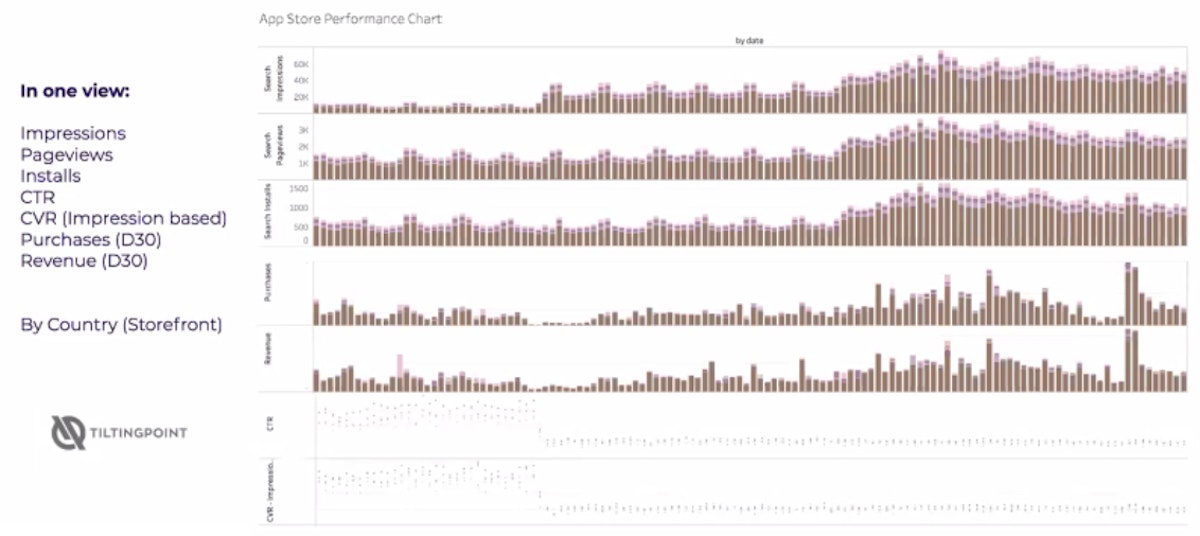
Tilting point’s main dashboard – Aggregating the main store metrics in one view.
On Google Play, retention is extremely important and must be taken into account. Analysing the correlation between retention and traffic can bring valuable insights. Also, crashes can have a negative impact on your visibility but Google Play might take 30 days to reflect it.
Finally, to report performance when running ASA campaigns, Nadir recommends to subtract MMP ASA Installs* from App Store Connect App Units. Another option is to use App Store Connect Sales/by IAP* minus MMP ASA Sales/IAP. By looking at App Store performance charts and Apple Search Ads performance charts side by side, you can spot trends and see how metrics evolve over the same time periods.
*MMP: Mobile Measurement Partner
*In-App Purchases
3. Reaching Coherency between ASO, Performance Marketing and Brand
Natalie Drozd, Marketing Manager – Hily
How to combine cross-team knowledge in creating the Product Page that everyone will love? While ASO, Brand and Paid UA teams have the same long term goals, in the short term they may differ. Natalie Drozd, Marketing Manager at Hily explained that in order to solve that, each team must focus on its core responsibilities but overall share information, ask questions and listen to the others. First, the ASO team must embrace a “discoverability-first approach” by choosing relevant and high volume keywords with informative creatives. Secondly, regarding paid and performance marketing, the objective is to lower the price, maximize LTV by adopting a ROI-first approach. And thirdly, for the brand, the approach is centred around mission and values, with the end goal to imprint in people’s mind.
While each of these objectives is well defined, she stresses on the fact that there are overlaps between the teams and collaboration is key. Asking good questions can give rise to new ideas and generate value. For example, the ASO team can learn a lot from the brand and paid teams about the most performing visuals, ads designs, brand positioning and identity.

Framework: combining cross-team knowledge from awareness to conversion.
4. Using an NPS flow to optimize your ratings & reviews
Alex Gorius, Senior Growth Consultant – Phiture
Alice Muir, Growth Consultant – Phiture
Alex Gorius and Alice Muir at Phiture talked about how to best use NPS (Net Promoter Scores) which is a metric used to measure overall experience, or in other words happiness of users, on a scale of 0 to 10. Alice then explained the different benefits of using NPS:
- Minimize churn by better understanding detractors.
- Increase visibility by prompting promoters to refer your app to their entourage.
- Increase App Rating by encouraging promoters to rank your app.
- Improve your app by identifying product problems such as platform or localization issues.
Alex and Alice then highlighted the importance of collecting and gathering data on NPS over time to better understand detractors and leverage promoters. Through a NPS Dashboard built on Google Data Studio, they showed an example of how the data can be broken down and organized to get key insights about potential areas of improvement and better understand how different types of users respond to the app.
Also, they emphasized on the significance of finding the right balance between the different kinds of metrics when building a NPS by showing an example of a real case on Google Play. Finally, Alice reminded us of how Apple is strict when it comes to encouraging ratings and thus, be careful with the NPS design survey for iOS.
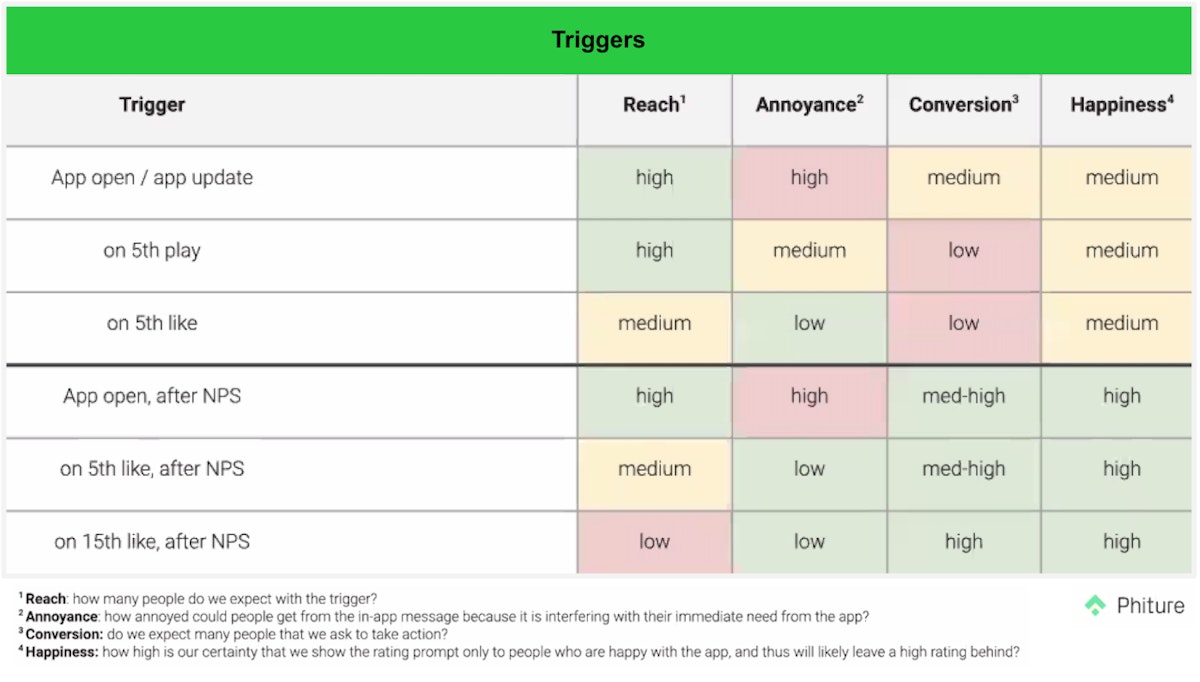
Triggers have better results when they occur after NPS and after many likes.
5. Panel: ASO & Brand
Louis Tanguay – App Growth Summit
Alexandra Lamachenka, Growth Manager – SkyScanner
Catherine Sibirko, ASO Expert – Flo Health
Ian Irving, Senior Data Analyst SEO & ASO – BBC
Mathew Parry, ASO Manager – Babbel
Panellists confirmed a very large part of their app installs come from only a few keywords, mostly branded keywords. However, ranking well on your most important generic keywords is still extremely important, as some users are looking for them without a brand in mind. It can be challenging to choose between generic and branded keywords, in particular on iOS where limitations of characters are more restrictive. A good practice is to test and monitor search volumes, rankings and other relevant metrics.
Everything must be aligned across channels but also internally. The ASO team needs to collaborate with product and branding. New features and positioning can influence the app’s title and metadata. During a brand activation campaign, you should also make sure everything is synchronized between channels.
Finally, a question was asked about whether we should attack competitors branded terms? All of them say no because it’s not allowed by the stores, but also because it was not effective when one of them tried some time ago. For well known branded terms, competitors might pay a lot of money but it seems to have a limited impact.
6. ASO In Japan: Understanding how to crack open the Japanese market.
Adzsa Hatano, ASO Expert at Phiture shared tips and insights for a successful keyword optimization and conversion rate optimization for the Japanese Market. As there can be up to 5 different keywords for one word, she highlighted the importance of researching and collecting all types of written versions of a keyword used in Japanese. Based on her experience, Japanese users tend to search with Hiragana on the App stores so keywords in Hiragana tend to have high Search Popularity. But, she recommends using the formal written version of a keyword in the visible assets (title, subtitle, short description, etc) regardless of Search Popularity. She also added an interesting remark that sometimes Japanese users find English keywords to be cool so it does not necessarily make sense to translate every single keyword.
As for creative assets, she emphasized the importance of understanding the seasonal events in Japan and leverage them by adapting and tweaking icons and screenshots accordingly. Also, she shared some small tips that can make the difference in Japan including the use of Kawaii, animism and text bubbles, as well as highlighting social proof and features in the first 3 lines of the long description. Finally, she focused further on screenshots and explained that successful imported apps have localized theirs by catering content and features to Japanese users, used Japanese influencers and models when possible, and followed category trends such as landscape screenshot for dating apps.
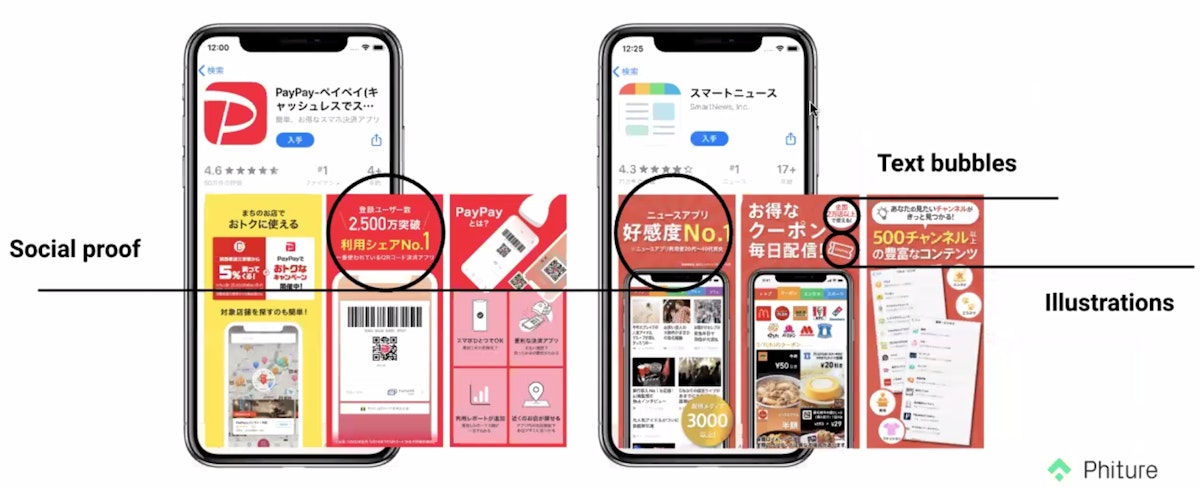
Screenshots are stuffed with many elements and highlight social proof.
7. An Open Q&A on the Forces of Organic Uplift
Gabe Kwakyi, Co-founder – Incipia
Marina Corby, Data Analytics Manager – Incipia
The term “organic uplift” is often used in the mobile industry. But what does it mean and how to factor it into your ASO strategy? The organic uplift, also known as “k-factor”, represents the number of organic downloads gained from one marginal paid download. It happens mostly hours or days after a paid download but it can be recognized weeks-to-month later. Gabe Kwakyi and Marina Corby explained that there are different types of organic uplifts, divided into two categories: user-level organic uplift, coming from different kinds of brand searches, and ecosystem organic uplift, coming from non-brand search, top chart rank, app list rank or brand awareness.
To model the relationships between your variables (paid installs, app store features, creatives) and an output (eg: organic installs), different statistical techniques can be used, each with its own interpretability and complexity. The simpler the model, the easier it is to take the output and apply it. Therefore, in order to grab the low hanging fruits, they recommend to start simple and increase gradually the method complexity based on your data. You should determine your business needs, look at the data and gather all the factors you can. To run tests, ideally, no UA campaigns should be conducted so there is no noise in your data that could mislead the results. A good idea might be to go to a market that has a low and stable baseline, as it will help the algorithm to understand what is happening. Finally, new apps on iOS often have a better organic uplift, as they benefit from high visibility during the first 7 days. They closed by emphasizing that Organic uplift pre-COVID-19 is not applicable anymore and that we should all spend some time to figure out what is the new normal.
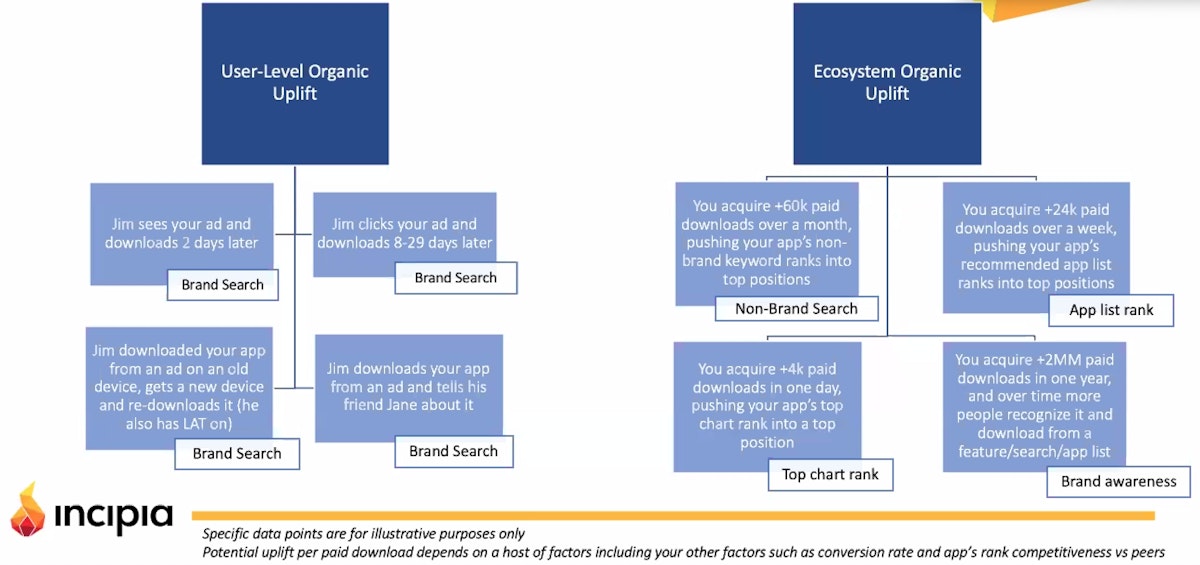
Incipia describes organic uplift at the User-Level or from Ecosystem.
8. Panel: Synergies between ASO & Apple search Ads
Moderator: David Llewellyn, Marketing Director EMEA – Appsflyer
Panellist: Maryia Filimanchuk, Lead Marketing Manager – Apalon
Panellist: Quoc Anh Luong, Mobile Marketing Manager – OMIO
Panellist: Thomas Petit, Mobile Growth Expert
Many factors must be considered when looking for the best keywords to target, and lots of insights come from Search Ads. Some keywords will have high search traffic, some other high conversion rates or better monetization channels. A good practice is to create different keyword groups to see which ones perform better and where. A winning strategy might be to differentiate and go for low competition keywords.
ASA is not an end in itself, as Apple is not favouriting apps that put a lot of budget on ASA. While Apple will increase rankings on some keywords if download velocity due to ads is high, using ASA specifically is not proven to have an added value compared to other networks. Marketers should find the sweet spot when looking at the relationship between investment and visibility; ASA can help sometimes to bring downloads on some keywords, or it can give you a heads up in new markets. Finally, the golden rule is to target relevant keywords only, those who will give both visibility and retention. Buying traffic for some keywords that are not consistent with the value proposition of the app will not help. Therefore, there should be a synergy between keywords and landing page or screenshots. The best results will be achieved only if ASA and ASO are well integrated, which implies to think broader than just about the keywords.
9. The Apple Search Ads (ASA) Stack: Introducing a cheat-sheet for running ASA.
Andrea Raggi, Search Ads Lead at Phiture, highlighted the benefits of Apple Search Ads and provided a cheat-sheet for how to run them effectively. He explained that Search Ads increase visibility, discoverability, and drive downloads as it allows you to advertise your app to 500 million weekly visitors in 60 countries on the Apple App Store. He proceeded by explaining the key terms and sharing a strategic framework with the different layers to consider for developing Apple Search Ads:
- Campaign: aims at properly organizing your account and helping better leverage the different tasks.
- Ad groups: help tailor and develop the strategy. Address a specific audience or optimize performance, which can help with ASO efforts.
- Keywords: can help reach scale, optimize performance and discover new keywords with the search match. It also helps you find some search terms that work better than others and that can be transferred to your ASO efforts.
- Tools: Support strategy through the study of the market, technical improvement and understanding of what the competitors are doing.
- Supporting insights: Enables to grasp the big picture. ASA improve keywords ranking at the organic level.
These 5 supporting layers are the foundation of ASA strategy for which the goals are to help scale the channel and optimize its performance. He finally added that the strategy does not need to cover everything at the same time and recommended to use it to improve the ASO conversion.

The 5 layers of the strategic Apple Search Ads framework, by Phiture.
Note: Release of ASA Stack on May 14th, 2020 to provide ASO Stack community with an overview of all available assets to grow an exhaustive strategy in Apple Search Ads.
10. How we have started our in-house localization team for app store optimization
Seyma Cam, Product Partnership Specialist at VLMedia walked us through the process of how they have built an effective localization team in-house to localize their app in 34 languages. She explained that they looked at 2 main elements when deciding which Geo’s to localize in:
- Where their users were and from where the most downloads and reviews/ratings were coming from.
- Where their competitors were localized and an in-depth analysis of their localization strategy in those markets.
Once the markets for localization were chosen, Seyma explained the steps its company undertook to build an in-house localization team:
- Find people that speak English and the foreign language targeted and have experience with mobile applications.
- Have each native employee be in charge of researching the cultural and language trends and be knowledgeable of the best ASO practises in that target market (Keyword Optimization and Creatives).
- Develop a tool to have all the translations in one place including in-app copy, store listing, and marketing.
She stressed the importance of experiments and choosing the right keywords for that specific market based on both research and the different metrics. Also, she explains how localization goes beyond ASO efforts and that the company has also localized promotions, email marketing, paid ads and everything else. Overall, localization allowed her company to increase revenue, retention rate and in-app purchases. It proved to bring positive results in both App Stores as the app, once localized, became more engaging and fun for the users.
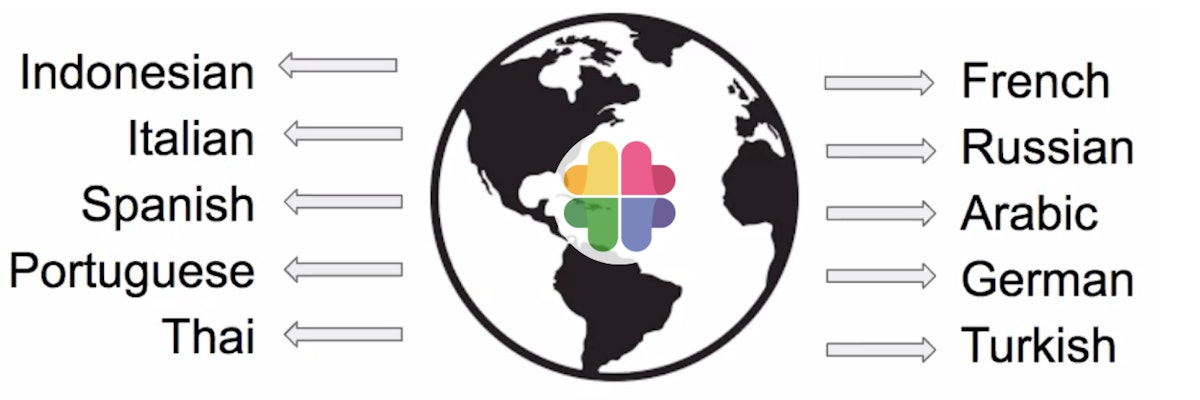
Localization had a positive impact on the conversion rate, retention, purchases and many other metrics.
11. Automating localization: Creating a Seamless Flow for 40+ Languages with the weekly release cycle
Ilia Kukharev, Head of ASO – Aviasales
Localization has huge benefits, such as better visibility for your app, monetization with Ads, more chances to get featured worldwide or unexpected boosts. However, as you keep developing your app, translating it in many languages on a regular basis can be extremely time-consuming. Ilia Kukharev, Head of ASO at Aviasales explained that by automating the process, the company managed to reduce the time needed for translations from 15% to just 1% of their work time. How? By using Crowdin, a cloud-based solution that streamlines localization management. You simply have to connect to GitHub, set up a branch and configure it. When new files need to be translated, freelancers or a translation agency will get an email. They need to log in and translate new stings, and you will get a confirmation when it’s done.

Aviasales automated the translations process and reduced their working time for the task by 15.
12. Dealing with False Positive A/B Tests Results in Google Play Experiments
Simon Thillay, Head of ASO – AppTweak
Our own Head of ASO, Simon Thillay, shared how some issues inherent to Google Play Experiments impact the reliability and trustworthiness of test results before presenting a new testing method aimed at improving the reliability of results.
- Lack of control on how users coming from different traffic sources as well as store weekly seasonality create a lot of statistical noise that can affect conversion in each sample of A/B test differently, leading to false-positive results.
- Getting enough downloads in each test sample is key to reaching good enough statistical power.
- Duplicating your new variant in your test so you have an A / B / B structure will help you compare if both B samples get similar or different results. Similar results from both B samples are likely to be trustworthy, whereas finding different results in each B sample means you probably were served a false-positive result.

Our recommended rules for the new A / B / B test format – AppTweak
Simon concluded by asking willing members in the audience to reach out to him to share their results, as he will be trying to compile some stats on the benefits from this new method, which will also be detailed longer on our blog very soon.
13. Rating libraries on iOS and Android
Sebastian Gallese, Founder – Haystack Reviews
It is well known that asking for ratings is extremely important. However, when your rating mechanism is hardcoded, it makes it difficult to experiment. Sebastian Gallese, Founder of Haystack Reviews explained that to solve that issue, developers can tap into existing libraries that will allow them to spend less time setting everything up, and more time for experimentation. For example, one might use “skent/Amplify” on Android, “Armchair“ on iOS or “skyost/RateMyApp” with Flutter. Sebastian also pointed out that while a native prompt is not yet available for Android, a test app which does include a native prompt mechanism has been spotted already some time ago, and marketers should prepare for the feature to hit the store soon and identify the best trigger mechanisms in consequence.
We hope you enjoyed the conference as much as we did! If you want to know more about AppTweak, don’t hesitate to check out our other blogs, book a demo or start a free trial!



 Simon Thillay
Simon Thillay

